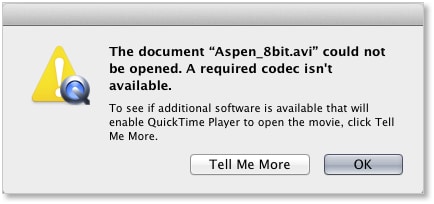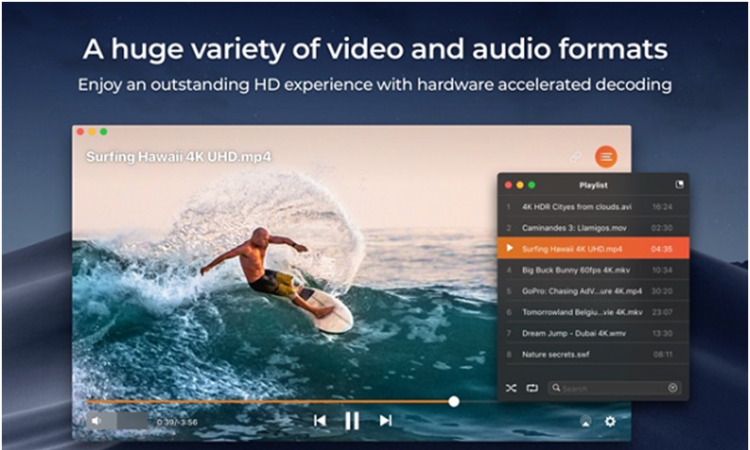For a Mac running Mountain Lion or later, converting AVI video to QuickTime is highly recommended. Elmedia Player: Universal Media Player. Flared with meeting user’s expectations, Elmedia Player is a renowned multi-media player amongst the users for playing high quality AVI files on Mac.
QuickTime Player User Guide
- What exactly is an AVI file and can QuickTime play AVI? AVI stands for Audio Video Interleave and it’s basically an open source multimedia container format. It defines how video and audio data is packed into a file. It allows for simultaneous playback between the interleaved audio and video in the file.
- OS: Windows and Mac. There are many programs to convert AVI to QuickTime; VLC does it quite well. VLC is a free, open-source, cross-platform media player for playing multimedia files, streaming protocols, and converting AVI files to MOV.
QuickTime Player has onscreen playback controls that let you play, pause, fast-forward, or rewind your video or audio file.
You can also use playback controls to share a file, or play a file on an AirPlay-enabled device.
Open a file
To open a video or audio file in the QuickTime Player app on your Mac, do any of the following:
Double-click the file in the Finder.
If your videos or audio files are in iCloud Drive, click iCloud Drive in the Finder sidebar, then double-click your file. See Use iCloud Drive to store documents on your Mac, iPhone, and iPad.
Choose File > Open File, then select a file, and click Open.
If a file is an older or third-party media format, QuickTime Player may convert it before playing.
Tip: You can also open a file you’ve worked with recently by choosing File > Open Recent.
Play a file
You can play and control a file using the playback controls that appear when the pointer is over the screen. You can fast forward and reverse play, and you can change the playback speed.
In the QuickTime Player app on your Mac, open a video or audio file.
Move the pointer anywhere over the video to show the playback controls. (Controls for audio files are always visible.)
Use the playback controls to play the video or audio file; you can drag the controls to move them out of the way.
If your Mac has a Touch Bar, you can use the playback controls in the Touch Bar.
You can vary the playback speed of a video using the forward or rewind button . To change the playback speed by 2x, 5x, 10x, 30x, or 60x, play the video, then click the forward or rewind button until your video plays at the desired speed.
You can also vary the playback speed in small increments (from 1.1x to 2x) by Option-clicking the forward or rewind button while the video is playing.
If you want the file you’re playing to appear in front of all other windows on your screen, choose View > Float on Top so a checkmark appears next to it. Choose it again to turn it off.

Play a video with picture-in-picture
With picture-in-picture , you can play a video in a resizable floating window, so you can see it on your screen, while you do other tasks on your computer.

In the QuickTime Player app on your Mac, open a video file.
Use the playback controls to play the video file.
Click the picture-in-picture button in the playback controls.
You can click and drag the picture-in-picture window to anywhere on the screen, or click and drag any edge of the window to resize it.
Click the full-screen button or the close button to close the picture-in-picture window.
Play a file in a continuous loop

You can set a video or audio file to play continuously, so that it plays to the end and then starts over from the beginning.
Open the video or audio file you want to loop.
Choose View > Loop so a checkmark appears next to it.
Click the Play button in the playback controls.
To turn off continuous play, choose the command again; the checkmark disappears.
Quicktime Will Not Play Avi Files
Navigate a video using timecode
You can change the display of the playback controls to show the elapsed time, frame count, or timecode (depending on the characteristics of the video).
Some media files display a timecode—an 8-digit code (00-00-00-00)—in the playback controls, instead of the 4-digit code showing the remaining time. The timecode shows source time information about a specific frame or recorded point, like the time of the original recording, or the frame number. When navigating a project, you can use the timecode to navigate to an exact location of a frame in the media file.
Change the display of the playback controls: Choose View > Time Display, then choose the display option you want.
Navigate to a specific time-coded frame: Choose View > Time Display > Go To Timecode, then enter the timecode you want.
Quicktime Can't Open Avi Files
You can also use keyboard shortcuts or gestures to open, play, or pause a file, and more. See Keyboard shortcuts and gestures.